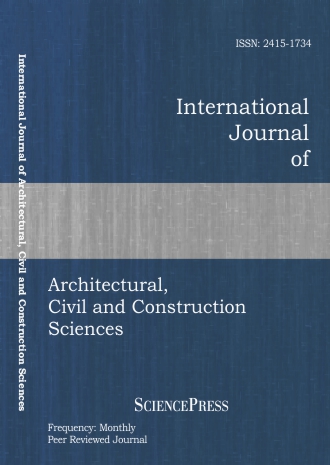
Scholarly
Volume:14, Issue: 8, 2020 Page No: 283 - 287
International Journal of Architectural, Civil and Construction Sciences
ISSN: 2415-1734
Identifying Areas on the Pavement Where Rain Water Runoff Affects Motorcycle Behavior
It is very well known that certain vertical and longitudinal slopes have to be assured in order to achieve adequate rainwater runoff from the pavement. The selection of longitudinal slopes, between the turning points of the vertical curves that meet the afore-mentioned requirement does not ensure adequate drainage because the same condition must also be applied at the transition curves. In this way none of the pavement edges’ slopes (as well as any other spot that lie on the pavement) will be opposite to the longitudinal slope of the rotation axis. Horizontal and vertical alignment must be properly combined in order to form a road which resultant slope does not take small values and hence, checks must be performed in every cross section and every chainage of the road. The present research investigates the rain water runoff from the road surface in order to identify the conditions under which, areas of inadequate drainage are being created, to analyze the rainwater behavior in such areas, to provide design examples of good and bad drainage zones and to track down certain motorcycle types which might encounter hazardous situations due to the presence of water film between the pavement and both of their tires resulting loss of traction. Moreover, it investigates the combination of longitudinal and cross slope values in critical pavement areas. It should be pointed out that the drainage gradient is analytically calculated for the whole road width and not just for an oblique slope per chainage (combination of longitudinal grade and cross slope). Lastly, various combinations of horizontal and vertical design are presented, indicating the crucial zones of bad pavement drainage. The key conclusion of the study is that any type of motorcycle will travel for some time inside the area of improper runoff for a certain time frame which depends on the speed and the trajectory that the rider chooses along the transition curve. Taking into account that on this section the rider will have to lean his motorcycle and hence reduce the contact area of his tire with the pavement it is apparent that any variations on the friction value due to the presence of a water film may lead to serious problems regarding his safety. The water runoff from the road pavement is improved when between reverse longitudinal slopes, crest instead of sag curve is chosen and particularly when its edges coincide with the edges of the horizontal curve. Lastly, the results of the investigation have shown that the variation of the longitudinal slope involves the vertical shift of the center of the poor water runoff area. The magnitude of this area increases as the length of the transition curve increases.